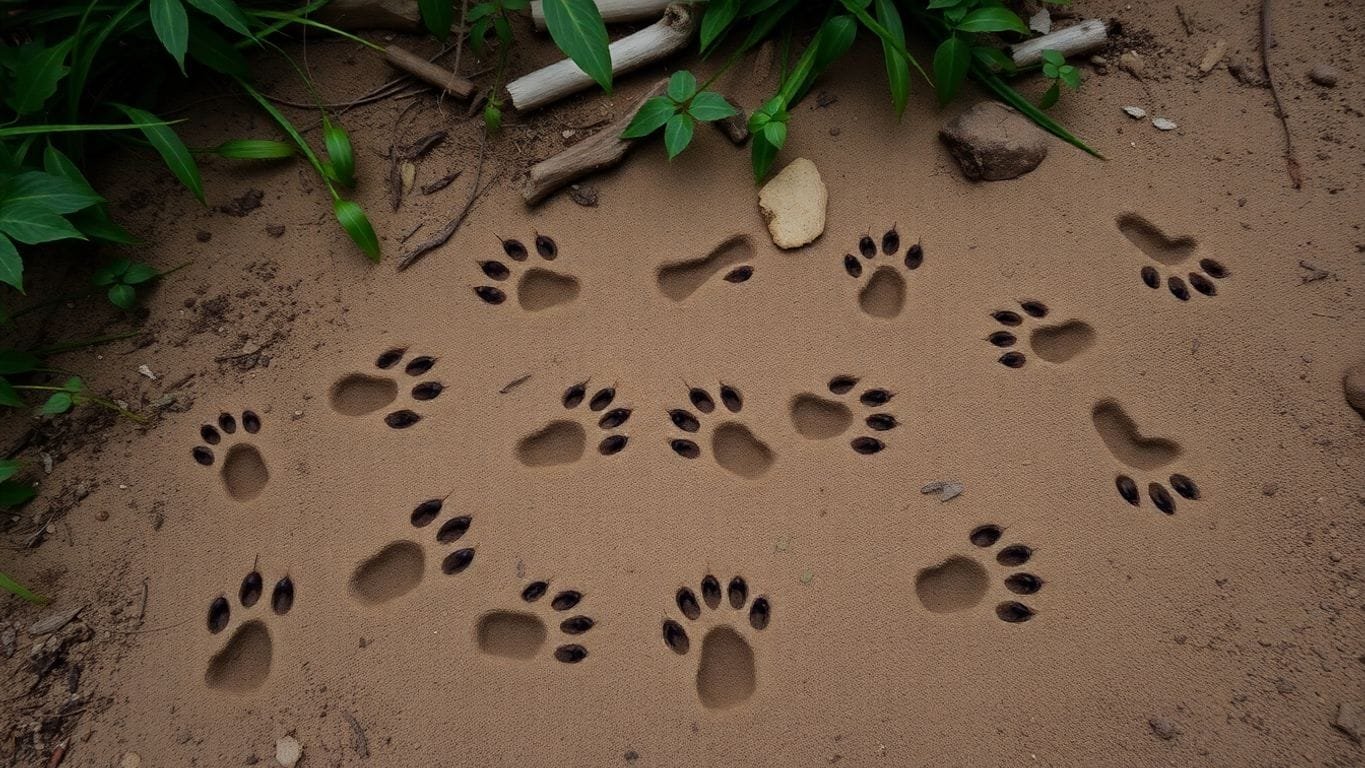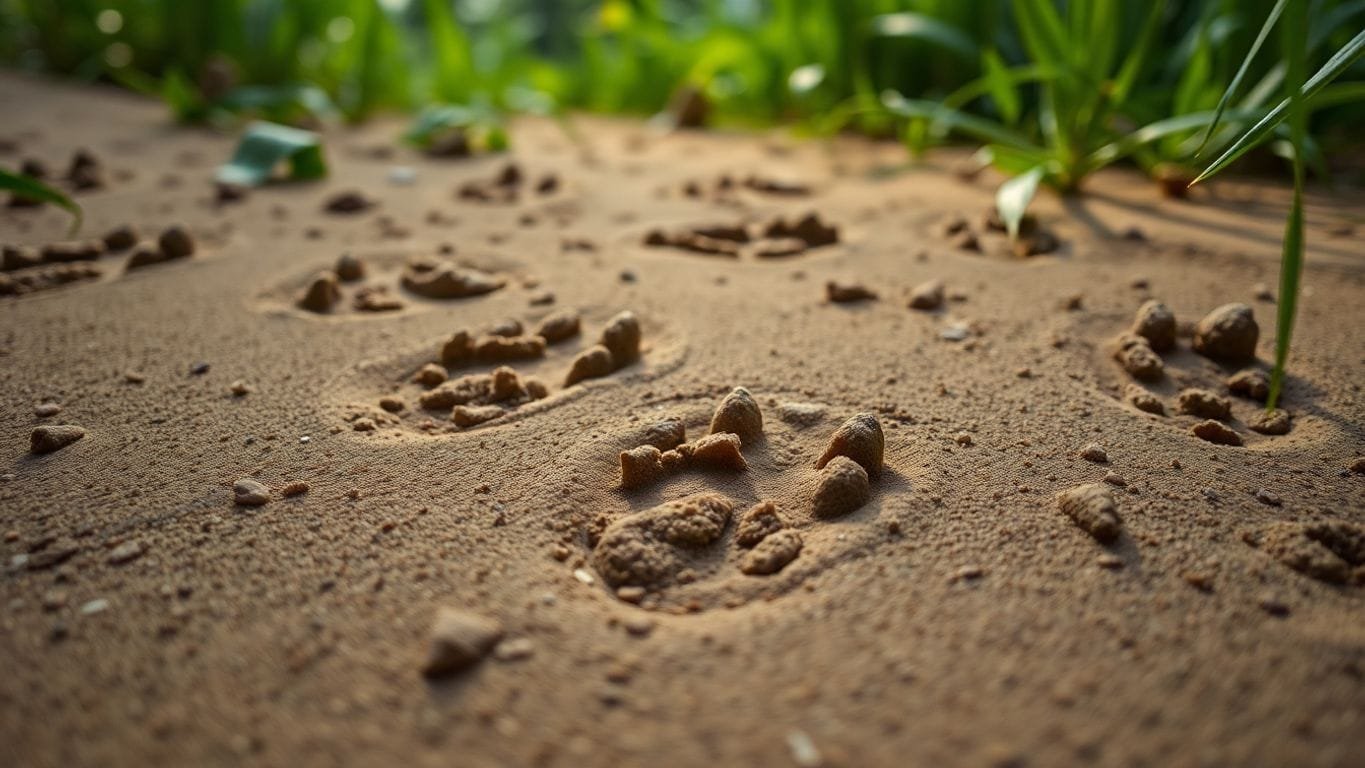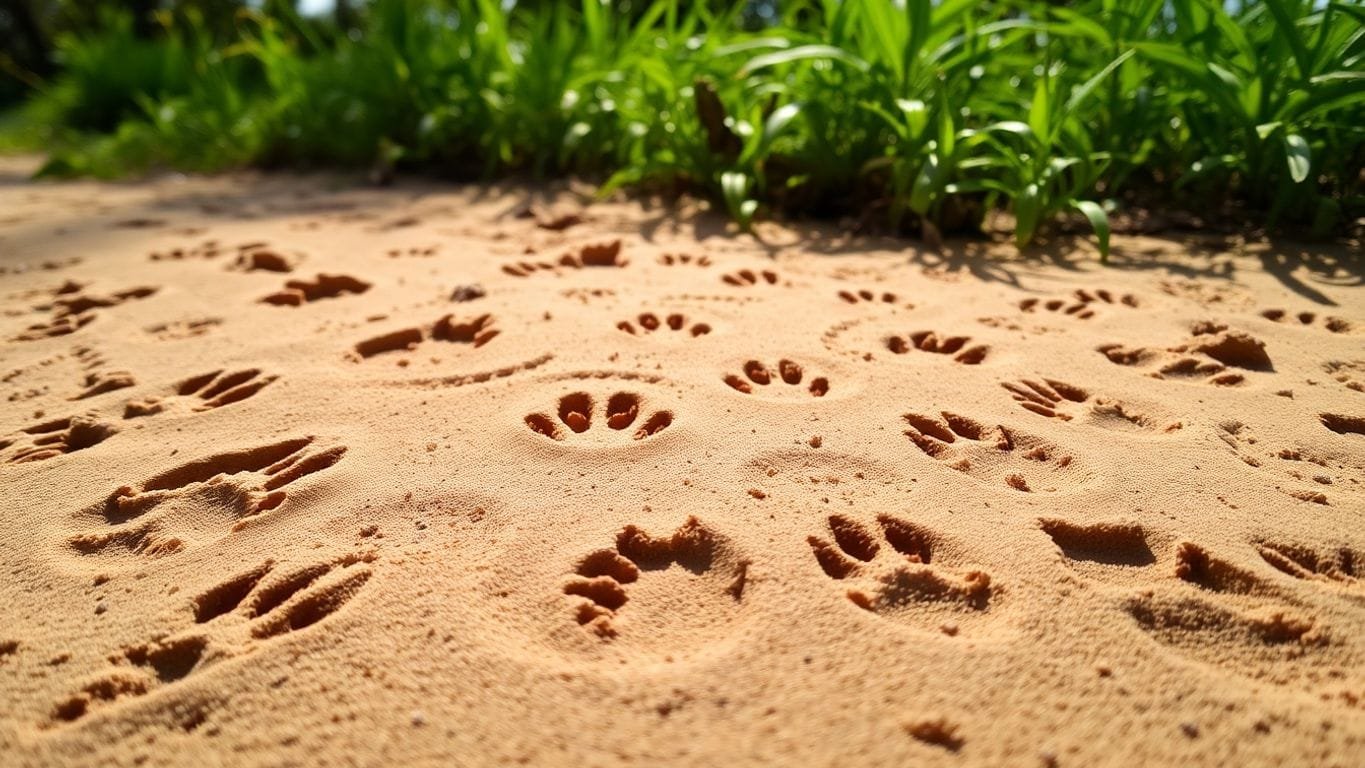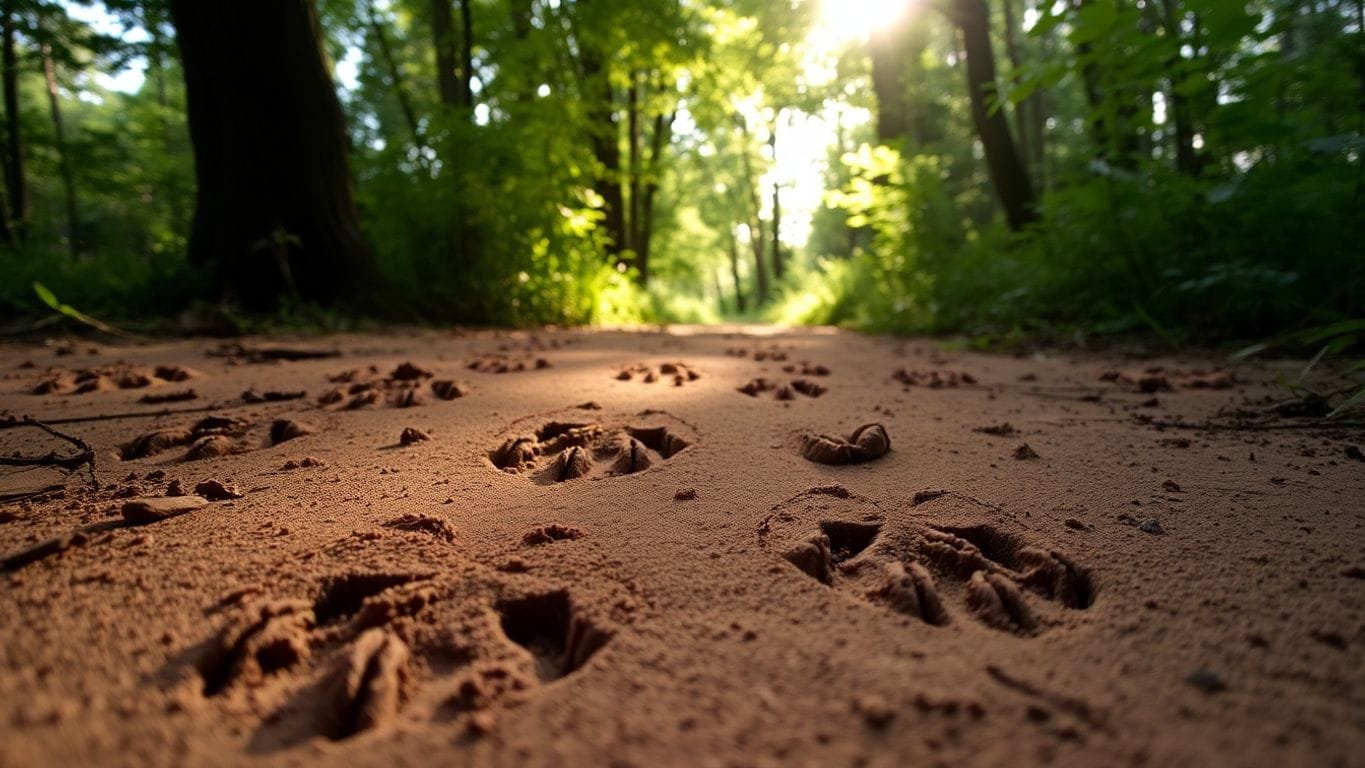Understanding animal tracks is essential for anyone interested in wildlife observation.
By learning to read these tracks, we can gain insights into the behaviors and movements of various species.
Reading Animal Behavior from Tracks — Quick Summary
Quick picks
What tracks say at a glance
- Stride + straddle: Long, even strides with narrow straddle often mean purposeful travel; short, uneven = foraging or injured.
- Track register: Rear foot landing on/near front (direct register) suggests stealth or energy saving (e.g., fox, lynx).
- Toe splay & depth: Wide splay and deep impressions indicate speed, load, or soft substrate; tight print = relaxed pace.
- Gait patterns: Walk (LR-LF-RR-RF), trot (diagonal pairs), lope and gallop reveal energy level and intent.
- Angles & pathing: Predators take straight lines; prey meander to feed and use cover—zigzags imply browsing.
- Overlap & scat: Tracks with fresh droppings, beds, or rubs confirm lingering behavior vs. transient movement.
- Interruptions: Sudden direction changes, skid marks, claw gouges can signal chase, spook, or pounce events.
- Substrate clues: Snow shows drag and kick; mud preserves toe marks; sand shows heel/edge collapse from speed.
- Aging signs: Crisp edges and intact micro-ridges = fresh; rounded edges, wind‑scour, debris fill = older.
- Human/gear signs: Boot tracks, dog prints, tire ruts can explain animal detours or elevated alertness.
Always cross‑check with habitat, season, and known local species.
This article will explore the basics of animal tracking, the science behind it, and practical techniques for both beginners and advanced trackers.
We will also discuss the ethical considerations and conservation efforts related to wildlife tracking, along with common mistakes to avoid. Whether you’re a novice or an experienced tracker, this guide will enhance your ability to observe and appreciate the natural world.
Understanding Animal Tracks: The Basics
When we step into the wild, we often find ourselves surrounded by signs of life, and animal tracks are like nature’s diary. They tell us stories about the creatures that roam the area.
Let’s dive into the basics of understanding these tracks!
Identifying Common Animal Tracks
To get started, we need to learn how to identify the tracks of different animals.
Here are some common ones:
- Deer: Look for cloven hooves, often in pairs.
- Rabbits: Small, round prints with a distinct hop pattern.
- Bears: Large, rounded prints with claw marks.
Tools for Tracking Wildlife
Having the right tools can make tracking much easier.
Here’s what we recommend:
- Field guide: A book or app that shows pictures of animal tracks.
- Notebook: To jot down your observations.
- Camera: Capture tracks for later reference.
Reading Track Patterns
Once we spot a track, we can learn a lot by observing its pattern.
Here are some things to consider:
- Depth: A deep track might indicate a heavier animal.
- Spacing: The distance between tracks can tell us about the animal’s speed.
- Direction: Following the direction can lead us to more signs of the animal.
Understanding animal tracks is not just about identifying them; it’s about connecting with nature and learning from it.
By learning these basics, we can start our journey into the fascinating world of wildlife tracking.
Remember, practice makes perfect, so let’s get out there and start observing!
The Science Behind Reading Animal Behavior from Tracks
Behavioral Clues in Tracks
When we look at animal tracks, we’re not just seeing footprints; we’re uncovering a story about the animal’s behavior.
Each track can tell us whether an animal was running, walking, or even stopping to rest.
For instance, a series of deep, wide tracks might indicate a heavy animal moving quickly, while lighter, more spaced-out tracks could suggest a leisurely stroll.
Interpreting Track Disturbances
Sometimes, we find disturbances around tracks, like broken twigs or scattered leaves.
These signs can reveal a lot about what happened in that spot.
Did the animal stop to eat? Was it startled?
Here are some things to consider:
- Direction of the tracks: Are they leading away from something?
- Depth of the impressions: Were they made in a hurry?
- Surrounding signs: Are there signs of feeding or resting nearby?
Seasonal Changes in Animal Tracks
As the seasons change, so do the tracks we find. In winter, snow can preserve tracks beautifully, while in summer, mud might show us more detail.
Understanding these seasonal shifts helps us predict animal behavior.
For example, during migration seasons, we might see different patterns as animals travel to find food or mates.
By paying attention to these details, we can connect with nature in a deeper way, understanding the lives of animals around us.
In summary, reading animal tracks is like piecing together a puzzle.
Each track, disturbance, and seasonal change adds to our understanding of wildlife behavior, making our observations more insightful and rewarding.
Highlights
- Behavioral Clues in Tracks: Each track tells a story.
- Interpreting Track Disturbances: Look for signs around the tracks.
- Seasonal Changes in Animal Tracks: Tracks change with the seasons.
Tracking Techniques for Beginners
Essential Gear for Tracking
When we start tracking wildlife, having the right gear is super important.
Here’s a quick list of essentials:
- Binoculars: Great for spotting animals from a distance.
- Field Guide: Helps us identify tracks and signs.
- Notebook: Perfect for jotting down observations.
Remember, the right gear can make all the difference!
Basic Tracking Skills
To become good at tracking, we need to develop some basic skills. Here are a few to focus on:
- Observation: Pay attention to details like footprints and droppings.
- Patience: Sometimes, we have to wait quietly to see animals.
- Knowledge: Learn about the animals in our area and their habits.
Safety Tips for Tracking Wildlife
While tracking can be fun, we must also stay safe. Here are some tips:
- Stay Alert: Be aware of our surroundings and any potential dangers.
- Travel in Groups: It’s safer and more enjoyable to track with friends.
- Know the Area: Familiarize ourselves with the terrain and any wildlife that might be present.
Tracking wildlife is not just about finding animals; it’s about connecting with nature and understanding the world around us.
By following these techniques, we can enhance our tracking experience and gain valuable insights into animal behavior. Happy tracking!
Advanced Tracking Methods
Using Technology in Tracking
In today’s world, technology has really changed how we track animals.
We can now use GPS collars and other devices to gather detailed information about animal movements.
These devices offer a reliable and easy way to monitor various wildlife species.
With this tech, we can see how animals behave in real-time and understand their habits better.
Advanced Pattern Recognition
When we look at animal tracks, we can use advanced methods to recognize patterns.
Here are some techniques we can use:
- Behavioral Change Point Analysis: This helps us find when an animal changes its movement style.
- Bayesian Models: These models help us predict animal behavior based on past data.
- Movement Mode Classification: This involves categorizing movements into different types, like wandering or encamped.
Tracking in Different Terrains
Tracking animals isn’t the same everywhere. Different terrains can change how we read tracks.
Here’s what we need to consider:
- Forest vs. Open Fields: Tracks in dense forests can be harder to see than in open areas.
- Wetlands: Muddy areas can preserve tracks better than dry ground.
- Urban Areas: Animals in cities might leave different signs than those in the wild.
Understanding these factors can help us become better trackers and observers of wildlife.
By combining technology with our tracking skills, we can gain deeper insights into animal behavior and contribute to wildlife conservation efforts. Let’s keep exploring and learning!
Case Studies: Real-World Tracking Examples

Tracking Deer in Forests
When we think about tracking deer, we often picture quiet walks through dense woods.
Deer tracks can tell us a lot about their habits.
Here’s what we usually look for:
- Track Size: Adult deer tracks are about 2-3 inches wide.
- Gait Patterns: A series of tracks can show if they were walking, running, or even bounding.
- Scat: Finding droppings nearby can help us understand their diet and health.
Following Bear Tracks
Bears are fascinating creatures, and tracking them can be thrilling! Here’s how we do it:
- Look for Claw Marks: Bear tracks often show claw marks, which can help us identify the species.
- Check for Scat: Bear scat can reveal what they’ve been eating, from berries to fish.
- Observe Disturbances: Broken branches or dug-up ground can indicate where a bear has been foraging.
Observing Bird Movements
Bird tracking is a bit different but equally exciting. Here’s what we focus on:
- Footprints: Small, delicate tracks can tell us which birds are around.
- Feeding Signs: Look for seeds or insects scattered on the ground.
- Nesting Areas: Finding nests can give us insight into breeding behaviors.
Tracking wildlife is not just about finding footprints; it’s about understanding their world and respecting their space. We must always remember to practice responsible wildlife viewing to minimize our impact on their habitats.
By learning to read these signs, we can gain a deeper appreciation for the wildlife around us and ensure we’re observing them ethically. Let’s keep exploring!
The Role of Environment in Animal Tracking

When we think about tracking animals, we often focus on the tracks themselves.
But the environment plays a huge role in how those tracks are made and what they tell us. Let’s dive into some key points about how different factors affect animal tracking.
Impact of Weather on Tracks
- Rain and Snow: Wet conditions can wash away tracks, while snow can preserve them, making it easier to see details.
- Temperature: Extreme heat can dry out tracks quickly, while cooler temperatures can keep them visible longer.
- Wind: Strong winds can shift sand or leaves, covering tracks and making them harder to find.
Understanding Habitat Influence
- Type of Terrain: Different terrains, like forests or open fields, affect how tracks are formed. For example, soft soil in a forest can show more detail than hard ground.
- Vegetation: Dense bushes can hide tracks, while open areas make them easier to spot.
- Water Sources: Animals often travel near water, so knowing where these are can help us find tracks.
Human Impact on Animal Behavior
- Urban Development: As we build more, animals may change their paths, which can alter the tracks we find.
- Pollution: Noise and light pollution can scare animals away from certain areas, affecting where they leave tracks.
- Conservation Efforts: Understanding how our actions impact wildlife can help us create better tracking methods and protect habitats.
By observing how the environment influences animal tracks, we can gain deeper insights into their behavior and movements. This knowledge is crucial for effective wildlife observation and conservation efforts.
In summary, the environment is not just a backdrop; it’s a key player in the story of animal tracking. By paying attention to these factors, we can become better trackers and observers of wildlife.
Ethical Considerations in Wildlife Tracking
When we dive into the world of wildlife tracking, it’s super important to think about the ethical side of things.
Respecting wildlife boundaries is key to ensuring that our tracking efforts don’t disturb the animals we’re trying to observe.
Here are some things we should keep in mind:
Respecting Wildlife Boundaries
- Always maintain a safe distance from animals to avoid causing them stress.
- Avoid tracking in sensitive areas, especially during breeding or nesting seasons.
- Be mindful of the impact our presence can have on their natural behaviors.
Minimizing Human Impact
- Use non-invasive tracking methods whenever possible.
- Leave no trace behind; pack out what you pack in.
- Educate others about the importance of ethical tracking practices.
Legal Aspects of Tracking
- Familiarize ourselves with local laws regarding wildlife tracking and conservation.
- Ensure that we have the necessary permits for tracking in protected areas.
- Understand the consequences of illegal tracking activities, which can harm both wildlife and our reputation as responsible observers.
Tracking wildlife is not just about gathering data; it’s about fostering a respectful relationship with nature. Let’s make sure our actions reflect that!
By keeping these ethical considerations in mind, we can enjoy the thrill of tracking while also protecting the wildlife we love. Remember, our goal is to observe, not to interfere!
Educational Programs and Resources

When it comes to learning about animal tracking, there are tons of resources out there that can help us get started. Whether we’re beginners or seasoned trackers, there’s something for everyone!
Workshops and Courses
- Local wildlife organizations often host workshops.
- Online courses are available for flexible learning.
- Community colleges may offer classes on animal behavior and tracking.
Books and Guides
- Look for field guides that focus on animal tracks.
- Books on animal behavior can provide deeper insights.
- Practical tracking manuals are great for hands-on learning.
Online Communities for Trackers
- Join forums where we can share experiences and tips.
- Social media groups can be a fun way to connect with fellow enthusiasts.
- Websites dedicated to wildlife tracking often have valuable resources.
Remember, the more we learn about animal behavior, the better we can understand and respect wildlife.
In our journey to decode nature, we can also explore specialized programs like those focusing on tracking behavioral observations in shelter animals.
These programs often provide practical tips that can enhance our skills. Additionally, engaging with animal science lessons can be a fun way to teach younger audiences about the fascinating world of animal behavior!
Conservation Efforts Through Tracking

Tracking for Conservation
Tracking wildlife is not just about following footprints; it’s a vital part of conservation efforts. By monitoring animal movements, we can gather crucial data that helps protect endangered species.
This data can inform us about their habits, habitats, and how they interact with their environment.
Here are some key points about tracking for conservation:
- Understanding Migration Patterns: Knowing where animals go during different seasons helps us protect their routes.
- Identifying Critical Habitats: Tracking can reveal important areas that need protection, like breeding grounds or feeding sites.
- Assessing Population Health: By tracking movements, we can estimate population sizes and health, which is essential for conservation planning.
Success Stories
There are many success stories where tracking has made a difference.
For instance, in Canada, conservationists have dedicated 12.1% of land to conservation, focusing on protecting unique wildlife. This commitment is crucial for maintaining ecosystem health and safeguarding endangered species.
Here are a few examples:
- Tracking Wolves: By monitoring wolf packs, researchers have been able to manage their populations effectively.
- Bird Migration Studies: Tracking migratory birds has led to better protection of their habitats along migration routes.
- Marine Life Monitoring: Using technology to track fish movements has helped in creating sustainable fishing practices.
Future of Wildlife Tracking
The future looks bright for wildlife tracking.
With advancements in technology, we can gather more accurate data than ever before. This means better conservation strategies and a greater chance of saving endangered species.
Tracking wildlife is not just about data; it’s about making a difference in the world. Let’s keep pushing for innovative solutions to protect our planet’s amazing creatures!
Common Mistakes and How to Avoid Them
When we dive into the world of tracking wildlife, it’s easy to trip up. Here are some common mistakes we often make and how we can dodge them:
Misidentifying Tracks
- Always double-check: Sometimes, we think we’ve found a deer track, but it could be a dog’s!
- Use a guidebook: Having a reference handy can help us spot the differences.
- Ask for help: If we’re unsure, reaching out to fellow trackers can clear things up.
Overlooking Environmental Factors
- Weather matters: Rain can wash away tracks, while snow can hide them. We need to be aware of how conditions affect what we see.
- Look for signs: Besides tracks, we should also pay attention to droppings and diggings. These can tell us a lot about what animals are around.
- Timing is key: Some animals are more active at dawn or dusk. Tracking during these times can yield better results.
Ignoring Safety Protocols
- Stay alert: Wildlife can be unpredictable. We should always be aware of our surroundings.
- Travel in groups: It’s safer and more fun to track with friends.
- Know the area: Familiarizing ourselves with the terrain can help us avoid dangerous spots.
Remember, tracking is a skill that takes time to develop. Learning from our mistakes is part of the journey!
By keeping these tips in mind, we can enhance our tracking skills and enjoy our time in nature even more!
Integrating Traditional Knowledge with Modern Tracking
Learning from Indigenous Practices
When we think about tracking, we often focus on the latest gadgets and technology.
But traditional knowledge from indigenous cultures can teach us a lot!
These communities have been observing animal behavior for generations. They understand the land and its creatures in ways that modern science is just starting to appreciate.
Here are some key points:
- Indigenous trackers often use natural signs, like plants or animal calls, to find animals.
- They have a deep understanding of seasonal changes and how they affect animal behavior.
- Their methods are often more sustainable, respecting the balance of nature.
Combining Old and New Techniques
We can blend these traditional methods with modern tracking tools for a more complete picture. For example, using GPS collars alongside indigenous tracking can help us:
- Gather more data on animal movements.
- Understand behavioral patterns in different environments.
- Enhance conservation efforts by respecting local knowledge.
Benefits of a Holistic Approach
By integrating these two worlds, we can create a more effective tracking strategy. This approach not only helps in understanding wildlife but also fosters respect for indigenous cultures. It’s a win-win!
In the end, combining traditional knowledge with modern technology can lead to better wildlife conservation and a deeper understanding of our natural world.
In summary, as we explore animal tracking, let’s not forget the wisdom of those who have walked this land long before us. Their insights can guide us in our quest to understand and protect wildlife.
Together, we can make a difference!
Wrapping It Up: The Joy of Tracking Animal Behavior
In conclusion, tracking animal tracks is not just about finding footprints; it’s about connecting with nature in a fun and exciting way.
By learning to read these signs, we can discover the stories behind the animals we share our world with. Whether it’s a deer’s delicate prints or a raccoon’s curious paw marks, each track tells us something unique.
So, next time you’re out in the wild, take a moment to look down. You might just uncover a whole new side of nature that you never knew existed. Happy tracking!
FAQ — reading animal behavior from tracks
Decode movement. Read intent. Make smarter calls.
A lot. Track patterns show if an animal was relaxed, hunting, or fleeing. Wide, even steps and meandering lines suggest calm movement. Long strides, direct lines, and churned substrate point to pursuit or escape. Clustered tracks near cover or food hint at feeding or bedding behavior.
Study the pattern: walk (diagonal or pace), trot/lope, bound, or gallop. Walks with short, even strides = low stress. Bounds and gallops with long groupings = urgency or chase. Measure stride and track groupings; increasing stride and tighter, straighter trails mean higher speed and arousal.
Look for toe orientation and pressure releases. Toes and claw marks point forward; soil pushed up at the front of the print shows the exit. Drag lines from tails or webbing also point downstream of travel. In snow, crisp entry and feathered exit often mark forward motion.
Check edge sharpness, weathering, and overlays. Sharp rims with moisture or sheen = fresh. Sun‑softened edges, collapsed walls, or debris blown into the print = hours to days. Compare with known-age control prints you make nearby to calibrate for that substrate and weather.
Count toes and look for claws, then measure track and stride. Note foot type—plantigrade, digitigrade, or unguligrade—to narrow groups. Scan the trail for scat, feeding sign, and habitat context. Use mud, sand, or thin snow for clean casts; photograph with a scale for later review.


